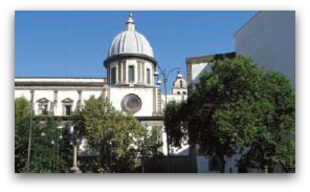
- Facciata laterale e cupola, particolare
The church's name refers to the proximity to ancient springs (called "formali d'acqua").The church was founded by the families Zurlo and Aprano. In 1451 the structure hosted the monks of the order of the Celestinis (founded by Celestino V).
The building is one of the most important Churches of the Neapolitan Renaissance. The works, started in 1505 on a project by Romolo Balsimelli, di Settignano, have been affected by Tuscan stylistic of Brunelleschi and Giuliano da Sangallo.
The 17th century Portal is by Francesco Antonio Picchiatti. In 1514 it is the great cloister realized by Fiorentino Della Cava. Further interventions were realised subsequently according to the Baroque taste.
The tunnel vault presents three panels in which episodes of the life of Saint Caterina are represented
by Luigi Garzi who also realized the corbels decorating the Dome, then finished by Paolo De Matteis in 1712.
The vault and the lunettes of the transept were frescoed by the Flemish Guglielmo Borremans between 1708 and 1709 and they represent St. Domenico and the Virgo that appease the Savior's anger. To the sides there is the Madonna 's apparition to St. Giovanni Evangelist and St. Domenico against the unfaithfuls.
The underlaing Chapel on the right of the Altar is dedicated to the Virgo, considered the artificer of
the victory in 1571, during the naval Battle od Lepanto. The other Chapel is dedicated to St. Domenico. The apse vault presents the Triumph of Giuditta by Borremans. Above the stoup, the tondo in high relief, representing th Virgo with her Child, is attributed to Annibale Caccavello (1540 ca).
The Chapels were decorated, in the 18th century, by Francesco Antonio Gandolfi.
Works by Paolo De Matteis, Santolo Cirillo, Paolo Tenaglia, Giacomo Del Po and Luigi Garzi can be admired on the walls. There are headstones and sepulchres of the family Spinelli, carried out by
Giovan Domenico and Girolamo D'Auria, Annibale and Salvatore Caccavello and Silla Longo, in the last quarter of the 16th century.
The wooden stalls are the work of Benvenuto Tortelli (1566). Under the altar of the fifth Chapel on the left, the relics of the blessed martyrs of Otranto, massacred by the Turks in 1489, are preserved.